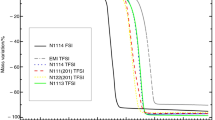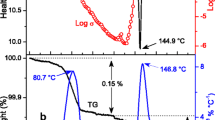Abstract
The electrochemical redox reactions: Fe(CN)6 4−−e−↔ Fe(CN)6 3−, Ru(NH3)6 3++e−↔ Ru (NH3)6 2+ and Fc(CH2OH)2−e−↔ Fc(CH2OH)2 + (Fc–ferrocene) were investigated in tetrabutylammonium halide hydrates at temperatures below and above the electrolyte melting point. They were studied by cyclic voltammetry, potential step chronoamperometry and impedance spectroscopy. Freezing of the electrolyte affects both the shape and position of the cyclic voltammogram on the potential scale. Also the shapes of the current-time relationship and the impedance spectra change at temperatures below the melting point. It has been proposed that this behaviour is caused by slow transport of the reactant and the heterogeneous nature of the electrolyte. The activation energies of reactant transport are about four times larger in frozen electrolytes than those in liquid. It has been concluded that reactant transport is restricted to the intergrain space of the electrolyte.
Similar content being viewed by others
Author information
Authors and Affiliations
Additional information
Received: 16 December 1997 / Accepted: 10 February 1998
Rights and permissions
About this article
Cite this article
Opallo, M. Electrochemical redox reactions studied in frozen tetrabutylammonium halide hydrates. J Solid State Electrochem 2, 347–354 (1998). https://doi.org/10.1007/s100080050111
Issue Date:
DOI: https://doi.org/10.1007/s100080050111




